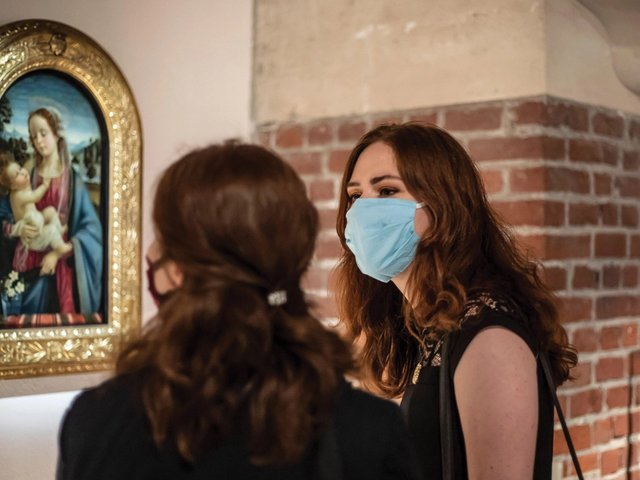“Ban selfie-takers from museums—these people don’t deserve to see great art,” read a headline on The Telegraph’s website earlier this year. In the article, the columnist Celia Waldon described her need to take “anger-management breaths” after finding Emile Jean Horace Vernet’s 1831 Portrait of a Lady blocked from view by a visitor with phone in hand.
“Ban selfies and you encourage people to take in their cultural heritage—perhaps even develop a little respect for it,” Waldon concluded.
She is not alone in calling for an end to selfie-taking in museums. Earlier in June, Florence’s Uffizi Galleries announced plans to place “precise limits” on the practice, after a visitor damaged a portrait by Anton Domenico Gabbiani while attempting to photograph himself with the work. Though the Uffizi could not share an update on its plans, the museum’s director previously described the move as intended to prevent “behaviour that is not compatible with the sense of our institutions and respect for cultural heritage”.
This incident, and the rounds of heated debate that followed, have highlighted a question—are selfies a vain distraction that pose a risk to works of art, or a useful tool through which visitors connect with cultural spaces?
Much depends on the museum, says Ross Parry, a professor of museum technology at the University of Leicester. “There are 1,700 accredited museums in the UK, and what we might always benefit from doing is noticing the sheer variety of those spaces and where they are on their journeys of digital maturity.”
For some institutions, a ban on selfie-taking could be an operational choice, tied to staffing levels, available space, or the types of objects on display, Parry says. He also points out that changes to policy can be for both positive and substantive reasons. In some instances, this can be to preserve the trust placed in museums to care not just for their visitors, but also for their collections.
We tried allowing photography, but had to revert back to our existing policy… because visitors often came very close to backing into the art when taking picturesspokesperson, Frick Collection
This is the reasoning behind the ban on all photography—not just selfies—at New York’s Frick Collection, which has been in place almost solidly for decades. “A few years ago we tried allowing photography, but had to revert back to our existing policy after a very brief period because visitors often came very close to backing into the art when taking pictures,” a museum spokesperson tells The Art Newspaper.
“The Frick Collection is virtually unique, and especially valued for its lack of protective barriers, vitrines and stanchions around works of fine and decorative art. Consequently, the policy of not permitting photography in galleries is driven by the need to ensure the safety of vulnerable works of art.”
This concern for collections is echoed by the Palazzo Maffei in Verona where, earlier this year, the artist Nicola Bolla’s sculpture Van Gogh Chair was damaged after a visitor attempted to photograph another sitting on the work. The institution does not plan to ban selfies, acknowledging their role in making art accessible, but it has since introduced enhanced protection measures for many works.
Concern over a lack of respect
The concerns are different at the Auschwitz-Birkenau Memorial and Museum in Poland, where selfies are permitted, but staff keep a watch online for photographs that “disrespect the memory of the victims of the camp”, says Paweł Sawicki, a museum press officer. “These are rather isolated incidents, but no matter how often they occur, we believe we must react”—on occasion, he says, “by contacting the authors or by trying to raise awareness and discussion through public opinion”.
“However, more often, we promote good photographs taken at the Memorial, whose role is to commemorate the history and victims of Auschwitz, as can be seen, for example, on our Instagram account,” Sawicki says. Often, he says, selfies or other photographs posted online are “accompanied by a very emotional message that shows that the author of such a photograph knew where he or she was” and took a picture to mark their visit.
“I think that, thanks to our presence on social media and continuous day-to-day educational work, the number of images that could be considered disrespectful is decreasing in the long run,” Sawicki says.
Of the positive outcomes often attributed to the museum selfie, increased accessibility, a more universal appeal and improved digital engagement are chief among them. Across the cultural sector, there have been a multitude of campaigns designed to capitalise on this.
Since its launch in 2014, museum selfie day—aimed at raising awareness of collections through images of visitors and staff—has led to over 100,000 Instagram posts being shared alongside the hashtag #MuseumSelfie. During the Covid-19 pandemic, institutions including the Getty Museum in Los Angeles asked home-bound visitors to take photographs of themselves reimagined as their favourite works of art, generating over 59,000 posts. And, at London’s National Gallery, content created by its 200 Creators influencer network was viewed over 42 million times last year, according to the museum.
The museum is there to be a place of co-creation and co-curationRoss Parry, professor of museum technology
While the medium may be modern, Parry points out that these engagement strategies are not new. Thanks to the guided tour, the museum has always been a social space, long before the mobile phone and the audioguide made hand-held media commonplace. “The museum is there to be a place of co-creation and co-curation, and not just a place of monologue and single authorship,” Parry says.
“So when we see those campaigns, we can rejoice in a museum sector that’s continually finding ways of including and partnering with its communities and its and its audiences. They are joyful and they are playful, and they are there to energise and to excite.”
Still, Parry says he understands museums regulating against selfies where they deem it to be operationally necessary. Given the huge diversity of institutions around the world, each with their own distinct collections and communities, he says he does not feel that there is a universal answer to the question of the museum selfie—or that there is a need for one.




